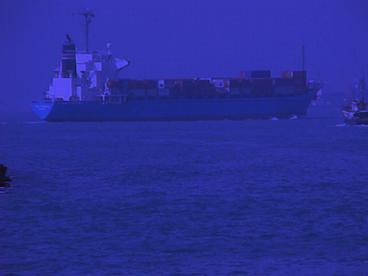Ships Routeing Systems - PowerPoint PPT Presentation
1 / 33
Title:
Ships Routeing Systems
Description:
They are systems of ways for ships in this water-part of the world where the ... of saving sailing time. Ships Routeing Systems. The Classification of Routes ... – PowerPoint PPT presentation
Number of Views:1185
Avg rating:3.0/5.0
Title: Ships Routeing Systems
1
Ships Routeing Systems
MARITIME OFFICE IN SZCZECIN
Presented by Joanna Rysiewicz
2
They are systems of ways for ships in this
water-part of the world where the density of
traffic is great or where freedom of movement of
shipping is inhibited by restricted sea-room, the
existence of obstructions to navigation, limited
depths or undesired meteorological conditions.
Ships Routeing Systems
Ships Routeing Systems
3
Why theShips Routeing Systemsexists ?
Ships Routeing Systems
4
According to Part A of the IMO publication,
Ships' Routeing, sets forth the General
Provisions on Ships Routeing (GPSR)
(resolution A.572(14), as amended) we may
distinguish causes as follows
Ships Routeing Systems
5
It helps navigators in the organization of
traffic flow within or around areas where
navigation by all ships or by certain classes of
ship carrying specific certain cargos or types
and big quantities of bunker fuel is dangerous or
undesirable.
Ships Routeing Systems
FIRST
6
Ships Routeing Systems
SECOND
It reduces the danger of collision between
crossing traffic and shipping in established
traffic lanes and makes the traffic flow easier
in areas of concentrated offshore exploration or
exploitation.
7
Ships Routeing Systems
THIRD
It is used for the purpose for preventing or
reducing the risk of pollution or other damage to
the marine environment caused by ships colliding
or grounding in or near environmentally sensitive
areas.
8
Ships Routeing Systems
Some conditions must be taken into account
- various weather,
- if water areas are ice-free,
- necessity of extraordinary manoeuvres,
- if under-keel clearance is adequate,
- the effects of meteorological and tidal influence
on water depths.
9
The Classification of Routes.
Ships Routeing Systems
10
Recommended routs.
Ships Routeing Systems
The Classification of Routes
11
Recommended tracksbetween two points with the
aim of saving sailing time.
Ships Routeing Systems
The Classification of Routes
12
One or two-way route with separation lines.
Ships Routeing Systems
The Classification of Routes
13
It could be created in canals or between natural
obstructions (as islands, shoals or rocks), which
are restricting free movement and providing a
natural division for opposing traffic streams .
We use lines, because there is too narrow for
separation schemes.
Ships Routeing Systems
The Classification of Routs
14
If there is enough place, there is traffic
separation by separation zone and line...
Ships Routeing Systems
The Classification of Routes
15
Ships Routeing Systems
The Classification of Routes
Recommended direction of traffic flow between two
traffic separation schemes.
16
Traffic separation by separation zone(for
example separation of through) by providing
inshore traffic zones.
Ships Routeing Systems
The Classification of Routes
17
We can meet some routes in form sectorial
division of near traffic separation schemes
approaching to focal point.
Ships Routeing Systems
The Classification of Routes
18
Separation of traffic at roundabout.
Ships Routeing Systems
The Classification of Routes
19
Separation of traffic at a crossing.
Ships Routeing Systems
The Classification of Routes
20
Separation of traffic at a junction.
Ships Routeing Systems
The Classification of Routes
21
A junction, showing a separation line submitted
for a zone, where will be crossing traffic.
Ships Routeing Systems
The Classification of Routes
22
Precautionary area at focal point.
Ships Routeing Systems
The Classification of Routes
23
Precautionary area with recommended direction of
traffic flow around is
area to be avoided.
Ships Routeing Systems
The Classification of Routes
24
Precautionary area at a junction, with
recommended directions of traffic flow.
Ships Routeing Systems
The Classification of Routes
25
Area to be avoided.
Ships Routeing Systems
The Classification of Routes
26
Deep-water route (two-way).
Ships Routeing Systems
The Classification of Routes
27
One-way deep-water route (within a traffic
lane).
Ships Routeing Systems
The Classification of Routes
28
they should follow as closely as possible
existing patterns of flow, course alternations
along the route should be as few as possible, and
convergence areas and route junctions should be
kept to a minimum and should be as widely
separated from each other as possible
Ships Routeing Systems
What else should we know about routes
29
Ships Routeing Systems
What else should we know about routes
- they should be designed to allow optimum use of
aids to navigation in the area - route junctions and convergence areas should not
be placed where crossing traffic is expected to
be heavy
30
Resolution A.572(14)1 General Provisions on
Ships Routeing as amended by res. MSC.71(69)
and SN/Circ.204(MSC70) Annex Guidance Note
on the Preparation of Proposals on Ships
Routeing Systems and Ship Reporting Systems for
Submission to the Sub-Committee on Safety of
Navigation.
Ships Routeing Systems
31
Ships Routeing Systems
32
Detailed guidelines we will find in Standards
International Hydrographic
Organisation in the Field of Hydrographic
Measurement - S44.
Ships Routeing Systems
33
Ships Routeing Systems
FINI































